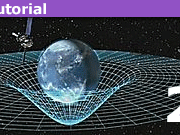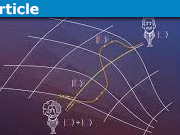Can We Tell Whether the Universe Is Rotating?
If you believe wholeheartedly in Mach’s principle, then there is no way to test empirically for the rotation of the universe as a whole, since there is nothing else for it to be rotating relative to. However, general relativity is not very Machian, and it offers a variety of ways in which an observer inside a sealed laboratory can detect whether the lab is rotating. For example, she can observe the motion of a gyroscope, or measure whether the Sagnac effect is zero. There are alternative theories of gravity, such as Brans-Dicke gravity, that are more Machian than GR,[Brans 1961] and in these theories, there is probably no meaningful sense in which the universe could rotate. However, solar-system tests[Bertotti 2003] rule out any significant deviations from GR of the type predicted by Brans-Dicke gravity, so that it appears that the universe is as non-Machian as GR says it is.
It is therefore possible according to general relativity to have cosmologies in which the universe is rotating. Historically, one of the earliest cosmological solutions to the Einstein field equations to be discovered was the Gödel metric, which rotates and has closed timelike curves. If we lived in a rotating universe such as Gödel’s example, the rate of rotation would have to be expressed in terms of angular velocity, not angular momentum. Angular velocity is what is measured by a gyroscope or the Sagnac effect, and GR doesn’t even have a definition of angular momentum that applies to cosmological spacetimes.
A rotating universe does not have to have a center of rotation, and it can be homogeneous. In other words, we could determine a direction in the sky and say that the universe was rotating counterclockwise at a certain rate about the line connecting us to that point on the celestial sphere. However, aliens living somewhere else in the universe could do the same thing. Their line would be parallel to ours, but there would be no way to tell whether one such line was the real center of rotation.
To find out whether the universe is rotating, in principle the most straightforward test is to watch the motion of a gyroscope relative to the distant galaxies. If it rotates at an angular velocity -ω relative to them, then the universe is rotating at angular velocity ω. In practice, we do not have mechanical gyroscopes with small enough random and systematic errors to put a very low limit on ω. However, we can use the entire solar system as a kind of gyroscope. Solar-system observations put a model-independent upper limit of 10-7 radians/year on the rotation,[Clemence 1957] which is an order of magnitude too lax to rule out the Gödel metric.
A rotating universe must have a certain axis of rotation, so it must have a particular type of anisotropy that picks out a certain preferred direction. We can therefore look at the cosmic microwave background and see whether its anisotropy contains a preferred axis.[Collins 1973] Such observations impose a limit that is tighter than provided by solar-system measurements (perhaps 10-9 rad/yr[Su 2009] or 10-15 rad/yr[Barrow 1985]), but such limits are model-dependent.
Because all of the present observations are consistent with zero rotational velocity, it is not possible to attribute any prominent cosmological role to rotation. Centrifugal forces cannot contribute significantly to cosmological expansion, or to the way your head feels when you’re hungover.
– Brans and Dicke, “Mach’s principle and a relativistic theory of gravitation,” Phys. Rev. 124 (1961) 925, http://loyno.edu/~brans/ST-history/
– Bertotti, Iess, and Tortora, “A test of general relativity using radio links with the Cassini spacecraft,” Nature 425 (2003) 374
– Clemence, “Astronomical time,” Rev. Mod. Phys. Vol. 29 (1957) 2
– Collins and Hawking, “The rotation and distortion of the universe,” Mon. Not. R. Astr. Soc. 162 (1973) 307
– Hawking, “On the rotation of the universe,” Mon. Not. R. Astr. Soc. 142 (1969) 529
– Barrow, Juszkiewicz, and Sonoda, “Universal rotation: how large can it be?,” Mon. Not. R. Astr. Soc. 213 (1985) 917, http://adsabs.harvard.edu/full/1985MNRAS.213..917B
– Su and Chu, “Is the universe rotating?,” 2009, http://arxiv.org/abs/0902.4575
The following forum members have contributed to this FAQ:
bcrowell
George Jones
jim mcnamara
marcus
PAllen
tiny-tim
vela
This article was authored by several Physics Forums members with PhDs in physics or mathematics.








“Does rotation of four dimensional space result in hyperbolic expansion of three dimensional sub-space with increasing time?”
There can’t be any invariant answer to this, because there is no preferred way to split up spacetime into “space” and “time”, so there is no invariant definition of “three-dimensional sub-space”.
Does rotation of four dimensional space result in hyperbolic expansion of three dimensional sub-space with increasing time?
The Cosmic Background Radiation experiment (COBE 2006) data indicated that overall rotation of the universe was zero, which was within the limits of accuracy of the instrument.In 1949, Kurt Gödel proved the existence of solutions involving closed time-like curves, to Albert Einstein's field equations within the Theory of General Relativity. His solution required a rotating universe, which would allow time travel to the past and caused Einstein to have doubts about his own theory. His solutions are known as the Gödel metric. Hollywood time travel stories are very popular 'Star Trek IV' etc. However, time traveller's from the future are either very discrete or choose to come to our period (I don't blame them!). Or the universe does not rotate significantly, as indicated by COBE.